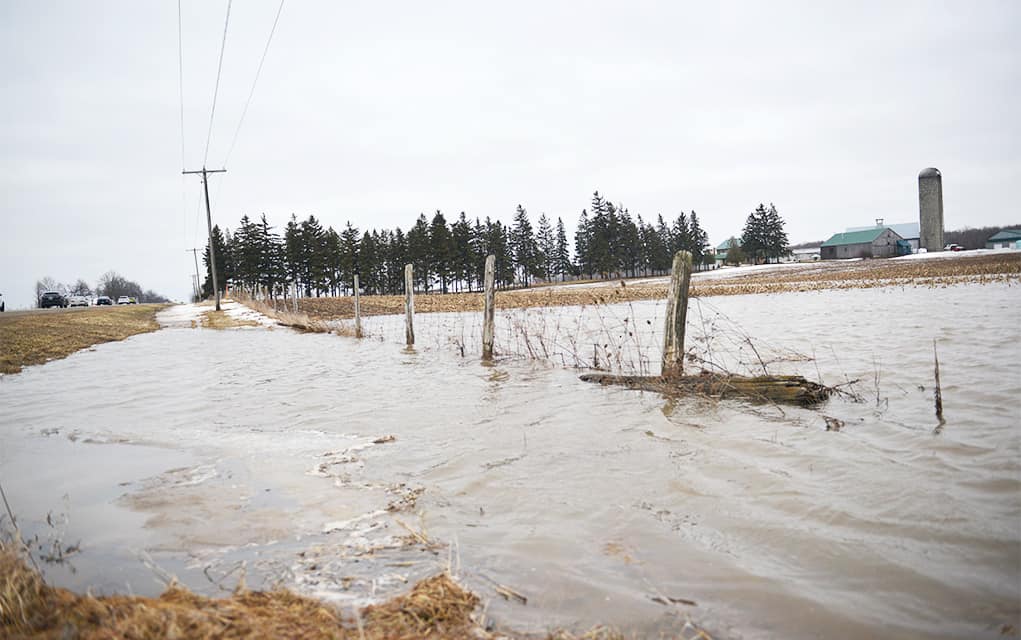Flood season has arrived. Areas along the Grand, Conestogo and Nith rivers and their tributaries are no exception.
At UW’s Intact Centre for Climate Change, the goal just now is to get information about flood preparation into the hands of residents via Bill 56, the Fewer Floods, Safer Ontario Act.
“The bottom line is the most expensive expression of climate change and extreme weather risk in Canada is the peril of flooding. And the specific aspect of the perils is residential basement flooding. Basements of homes flooding in Canada is the number-one cost of climate change. Period. And it is the number-one cost in Ontario,” said Blair Feltmate, the head of the Intact Centre.
Bill 56 would proclaim the fourth week in March to be Flooding Awareness Week, require the minister of Municipal Affairs and Housing to publish information on a government website on flooding issues and require information on flooding to be sent to taxpayers with their municipal tax bills.
Feltmate said he wrote to MPP Mary-Margaret McMahon, who serves the Beaches neighbourhood in Toronto, where flooding is becoming a problem for her constituents. She tabled the bill.
“Bill 56 is really promoting homeowner awareness of all these actions that can be taken to lower the probability of homes ending up with a flooded basement,” he said. “We’ve done a number of studies across the country whereby we have found that when people, homeowners are presented with this guidance on how to protect their homes from basement flooding, that six months later 70 per cent of people will have taken at least two actions to help limit their probability of basement flooding that they otherwise wouldn’t have taken.”
Feltmate says the average cost of a flooded basement in Canada is $43,000, with insurance caps generally decreased to between $10,000 and $20,000. Of note, the centre also calculated the sale price of homes in areas impacted by catastrophic floods is reduced by 8.2 per cent.
That all said, there are many things residents – homeowners and renters alike – can do to mitigate how much damage they sustain from floods, and protect their homes from floods, said Feltmate.
“There are many actions that people can take around the outside of their home and in the basement itself, generally speaking over a long weekend for less than a few hundred dollars, and not requiring specialized expertise that can be the difference between having a flooded basement versus not having a flooded basement.”
He listed some actions people can do for free: check the sump pump to make sure it’s working.
“Most people find out their sump pump doesn’t run these days when they have three and a half feet of sewer water in the basement. So maybe take ten or 15 minutes to check the sump pump.”
Another action is to go into the streets near your home and make sure the storm grates are not blocked with ice and debris. Another is to make sure your eavestrough is still connected, and that water isn’t pooling around the walls of your house, said Feltmate.
Other steps include installing plastic covers on window wells for ground level or basement windows, buying a battery backup supply for your sump pump in case electricity goes out or installing a backwater valve so that water can leave the overflow drain in your home, but can’t backup into your house. Feltmate said it’s important to maintain the valve by cleaning it regularly to make sure it seals properly.
Feltmate says the increase in flooding can be attributed to greater amounts of water coming down at once, and a loss of natural infrastructure.
“They’re not just climate change, bigger storms, greater volumes of water coming down over shorter periods of time, contributing to flooding. That’s a major factor, but we also have, for example, in southern Ontario, the loss of natural infrastructure. The forest, the fields, the wetlands that were originally here, they gave water a place to go in the landscape when the storms hit and to sit there and discharge slowly downstream or into the groundwater system. Over the last 100 years in southern Ontario, we’ve lost about 72, 73 per cent of the natural infrastructure that was originally here, it’s gone. It’s either paved over or turned into agricultural development. And when water hits these surfaces, it runs off very quickly. It doesn’t stay on the landscape and that contributes to flooding.
“And we also have aging municipal infrastructure, aging housing infrastructure. So through a combination of climate change bringing bigger storms, more intense rainfall events, combined with loss of natural infrastructure, combined with aging municipal infrastructure, basement flood risk is on the rise in Ontario.”
He also advised people to double check what kind of flooding coverage they have included in their insurance policies. He says there are three main types of flooding, and people need to ask for specific flooding coverage.









